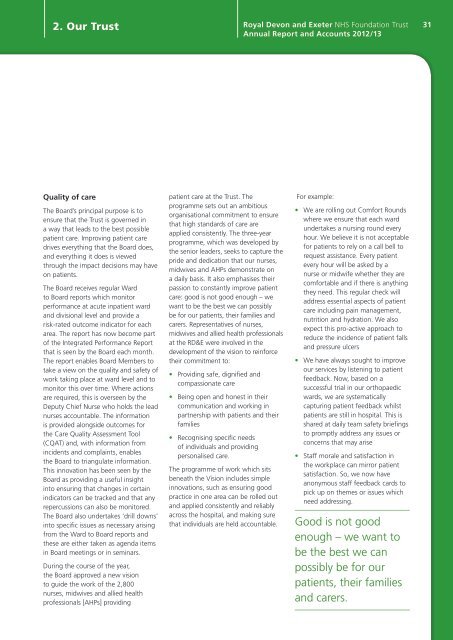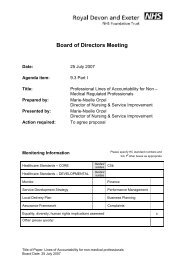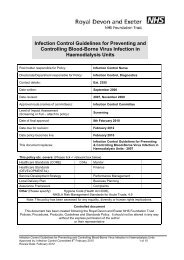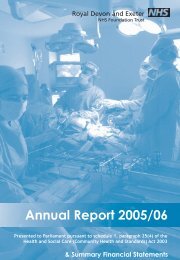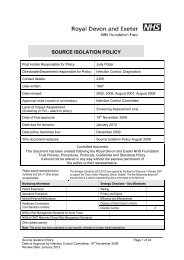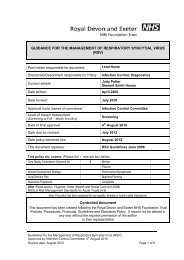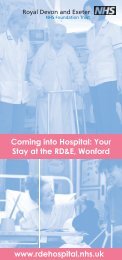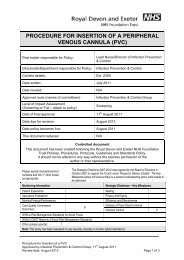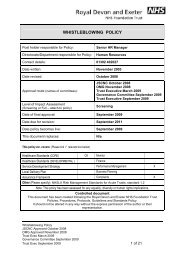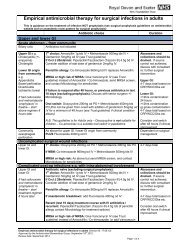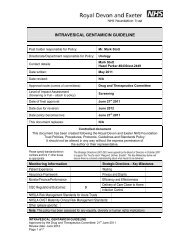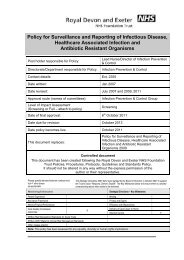Annual Report and Accounts 2012/13 - Royal Devon & Exeter Hospital
Annual Report and Accounts 2012/13 - Royal Devon & Exeter Hospital
Annual Report and Accounts 2012/13 - Royal Devon & Exeter Hospital
Create successful ePaper yourself
Turn your PDF publications into a flip-book with our unique Google optimized e-Paper software.
2. Our Trust <strong>Royal</strong> <strong>Devon</strong> <strong>and</strong> <strong>Exeter</strong> NHS Foundation Trust 31<br />
<strong>Annual</strong> <strong>Report</strong> <strong>and</strong> <strong>Accounts</strong> <strong>2012</strong>/<strong>13</strong><br />
Quality of care<br />
The Board’s principal purpose is to<br />
ensure that the Trust is governed in<br />
a way that leads to the best possible<br />
patient care. Improving patient care<br />
drives everything that the Board does,<br />
<strong>and</strong> everything it does is viewed<br />
through the impact decisions may have<br />
on patients.<br />
The Board receives regular Ward<br />
to Board reports which monitor<br />
performance at acute inpatient ward<br />
<strong>and</strong> divisional level <strong>and</strong> provide a<br />
risk-rated outcome indicator for each<br />
area. The report has now become part<br />
of the Integrated Performance <strong>Report</strong><br />
that is seen by the Board each month.<br />
The report enables Board Members to<br />
take a view on the quality <strong>and</strong> safety of<br />
work taking place at ward level <strong>and</strong> to<br />
monitor this over time. Where actions<br />
are required, this is overseen by the<br />
Deputy Chief Nurse who holds the lead<br />
nurses accountable. The information<br />
is provided alongside outcomes for<br />
the Care Quality Assessment Tool<br />
(CQAT) <strong>and</strong>, with information from<br />
incidents <strong>and</strong> complaints, enables<br />
the Board to triangulate information.<br />
This innovation has been seen by the<br />
Board as providing a useful insight<br />
into ensuring that changes in certain<br />
indicators can be tracked <strong>and</strong> that any<br />
repercussions can also be monitored.<br />
The Board also undertakes 'drill downs'<br />
into specific issues as necessary arising<br />
from the Ward to Board reports <strong>and</strong><br />
these are either taken as agenda items<br />
in Board meetings or in seminars.<br />
During the course of the year,<br />
the Board approved a new vision<br />
to guide the work of the 2,800<br />
nurses, midwives <strong>and</strong> allied health<br />
professionals [AHPs] providing<br />
patient care at the Trust. The<br />
programme sets out an ambitious<br />
organisational commitment to ensure<br />
that high st<strong>and</strong>ards of care are<br />
applied consistently. The three-year<br />
programme, which was developed by<br />
the senior leaders, seeks to capture the<br />
pride <strong>and</strong> dedication that our nurses,<br />
midwives <strong>and</strong> AHPs demonstrate on<br />
a daily basis. It also emphasises their<br />
passion to constantly improve patient<br />
care: good is not good enough – we<br />
want to be the best we can possibly<br />
be for our patients, their families <strong>and</strong><br />
carers. Representatives of nurses,<br />
midwives <strong>and</strong> allied health professionals<br />
at the RD&E were involved in the<br />
development of the vision to reinforce<br />
their commitment to:<br />
• Providing safe, dignified <strong>and</strong><br />
compassionate care<br />
• Being open <strong>and</strong> honest in their<br />
communication <strong>and</strong> working in<br />
partnership with patients <strong>and</strong> their<br />
families<br />
• Recognising specific needs<br />
of individuals <strong>and</strong> providing<br />
personalised care.<br />
The programme of work which sits<br />
beneath the Vision includes simple<br />
innovations, such as ensuring good<br />
practice in one area can be rolled out<br />
<strong>and</strong> applied consistently <strong>and</strong> reliably<br />
across the hospital, <strong>and</strong> making sure<br />
that individuals are held accountable.<br />
For example:<br />
• We are rolling out Comfort Rounds<br />
where we ensure that each ward<br />
undertakes a nursing round every<br />
hour. We believe it is not acceptable<br />
for patients to rely on a call bell to<br />
request assistance. Every patient<br />
every hour will be asked by a<br />
nurse or midwife whether they are<br />
comfortable <strong>and</strong> if there is anything<br />
they need. This regular check will<br />
address essential aspects of patient<br />
care including pain management,<br />
nutrition <strong>and</strong> hydration. We also<br />
expect this pro-active approach to<br />
reduce the incidence of patient falls<br />
<strong>and</strong> pressure ulcers<br />
• We have always sought to improve<br />
our services by listening to patient<br />
feedback. Now, based on a<br />
successful trial in our orthopaedic<br />
wards, we are systematically<br />
capturing patient feedback whilst<br />
patients are still in hospital. This is<br />
shared at daily team safety briefings<br />
to promptly address any issues or<br />
concerns that may arise<br />
• Staff morale <strong>and</strong> satisfaction in<br />
the workplace can mirror patient<br />
satisfaction. So, we now have<br />
anonymous staff feedback cards to<br />
pick up on themes or issues which<br />
need addressing.<br />
Good is not good<br />
enough – we want to<br />
be the best we can<br />
possibly be for our<br />
patients, their families<br />
<strong>and</strong> carers.


